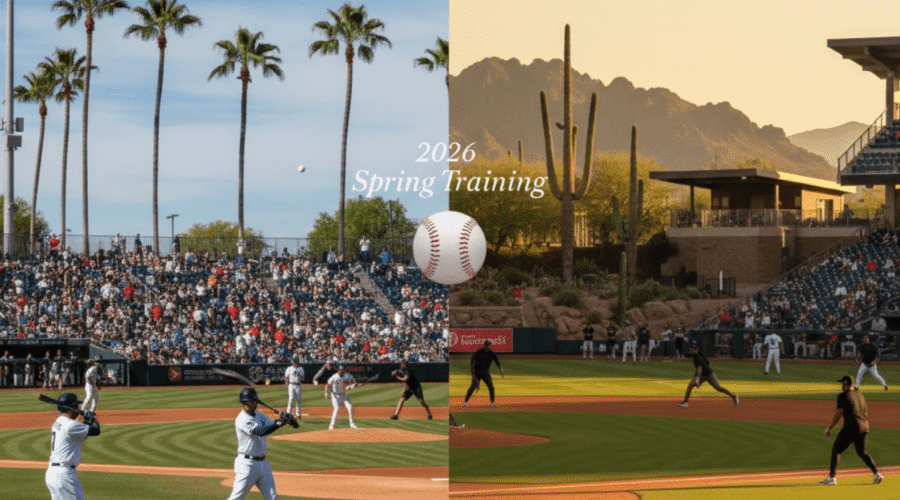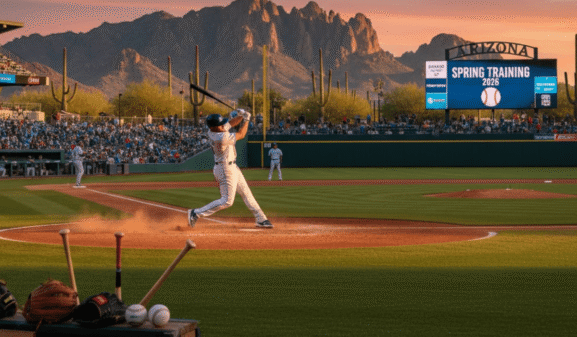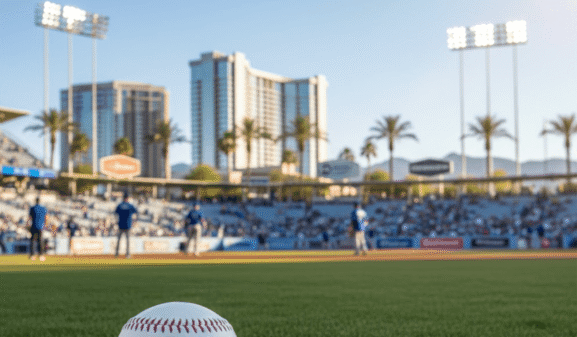When Does Spring Training Start in 2026? Florida & Arizona Baseball
Every winter, baseball fans across the country count down to the same magical moment: the crack of the bat echoing through sun-drenched stadiums in Florida and Arizona. Spring Training represents renewal, hope, and the promise that baseball is finally back. For 2026, MLB answered that question definitively with its early November schedule release, giving fans the green light to start planning their pilgrimage to the Grapefruit and Cactus Leagues.
Whether you’re a devoted Yankees fan ready to book your Tampa hotel or a casual observer curious about catching a few games in Scottsdale, understanding the 2026 Spring Training calendar is essential. This comprehensive guide breaks down exactly when the first pitch is thrown, how the schedule unfolds across both leagues, what’s different this year, and how to maximize your spring baseball experience.
Quick Takeaways
- Spring Training officially opens February 20, 2026, with select games in both Florida and Arizona leagues
- All 30 MLB teams launch full game schedules on February 21, 2026 — your best starting point for travel planning
- World Baseball Classic exhibition matchups occur March 3–4, 2026, across both training locations
- Most spring games conclude around March 24, 2026, with Opening Night following on March 25
- Unique crossover games and special venues (including Las Vegas) create one-of-a-kind experiences this spring
- Mid-March weekends offer the sweet spot, balancing veteran appearances with manageable crowds and ticket availability
When Does Spring Training Start — The Exact 2026 Dates You Need
Let’s cut straight to what matters most: the calendar. MLB’s 2026 Spring Training follows a structured rollout that gives teams time to ramp up while delivering fans early access to baseball.
First Games: February 20, 2026 A limited number of games kick off Spring Training on this Thursday, with select teams taking the field in both Arizona and Florida. This soft opening typically features a handful of matchups as organizations ease into game action following weeks of conditioning and early-camp workouts.
Read more: 2026 Spring Training Complete Schedule Announced: Your Ultimate Guide
Full Slate Begins: February 21, 2026 This Friday marks when all 30 MLB teams enter regular spring competition. From this date forward, you’ll find multiple games daily across both leagues, creating the authentic Spring Training atmosphere fans crave. If you’re planning a trip and want maximum game options, February 21 is your starting line.
World Baseball Classic Exhibitions: March 3–4, 2026 Adding international flavor to this year’s spring calendar, WBC tune-up games are scheduled across Arizona and Florida venues during this early March window. These special exhibitions showcase international rosters and provide a different competitive dynamic beyond standard club matchups.
Spring Training Conclusion: Approximately March 24, 2026 Most teams wrap their final spring games around this date, though exact finish times vary by club. Teams then shift focus to final roster decisions and travel preparations for the regular season.
Opening Night and Opening Day: March 25–26, 2026 MLB kicks off its regular season with a marquee Opening Night matchup on March 25 featuring the Giants versus the Yankees, followed by the traditional full Opening Day slate on March 26.
These anchor dates should drive every aspect of your Spring Training planning, from hotel reservations to ticket purchases.
Florida’s Grapefruit League — Timeline and What to Expect
The Grapefruit League stretches across Florida’s Gulf Coast and Atlantic shoreline, offering baseball fans a completely different experience than its Arizona counterpart. Florida’s geography means longer drives between stadiums, but also diverse coastal settings and a rich tradition of spring baseball dating back generations.
Schedule Flow and Structure
February 20 brings the inaugural Grapefruit League contests, with venues from Tampa to West Palm Beach hosting those first symbolic games. The following day, Florida’s spring training complex truly comes alive with a full schedule spanning famous facilities like George M. Steinbrenner Field, LECOM Park, and Champion Stadium.
Early-week schedules typically run lighter, with weekend slates packing in maximum action. This pattern continues through February and into early March, allowing teams to balance player development with fan access. The integration of college exhibitions in late February and early March adds variety, particularly for fans interested in scouting future talent.
The Florida Advantage
What makes the Grapefruit League special? Tradition weighs heavily here. Many franchises have trained in the same Florida cities for decades, creating deep community connections. The Yankees in Tampa, the Red Sox in Fort Myers, the Cardinals in Jupiter — these relationships matter to fans planning annual pilgrimages.
Florida also offers spring baseball within reach of other vacation activities. Families can combine beach days with ballgames or explore attractions between morning and afternoon games. The tradeoff is geography: hitting multiple stadiums in one day requires significant driving, unlike Arizona’s concentrated metro layout.
Timing Your Grapefruit League Visit
If star power drives your trip, mid-March weekends typically deliver. By this point, veterans are playing regular innings while prospects still get meaningful at-bats. The weather has warmed, crowds bring energy, and teams are fine-tuning rosters ahead of Opening Day.
However, smart planning means considering the early-March window too. Games scheduled between February 28 and March 10 often feature lighter attendance, easier parking, and better last-minute ticket availability while still delivering quality baseball. Most Grapefruit League action concludes around March 22–24, making the final full week your last chance for spring baseball before the regular season begins.
Arizona’s Cactus League — Timeline and What to Expect
Arizona’s Cactus League offers everything Florida does with one critical advantage: geography. Most spring facilities cluster within the Phoenix metropolitan area, creating unprecedented stadium-hopping opportunities. Fans routinely catch morning games in Surprise, afternoon contests in Scottsdale, and evening matchups in Tempe — all within 30 to 40 minutes of driving.
Schedule Structure and Highlights
Like Florida, Arizona opens with select games on February 20 before launching its complete schedule February 21. From that point forward, the Cactus League runs daily games through late March, typically concluding around March 24 as teams prepare for the regular season.
The 2026 calendar brings special intrigue with World Baseball Classic exhibitions on March 3–4, allowing fans to catch international talent in Cactus League venues. These games often draw passionate crowds representing multiple countries, creating an atmosphere distinct from typical spring matchups.
Cross-League and Special-Venue Games
One of 2026’s most interesting twists involves crossover matchups and unique locations. The Yankees, traditionally a Grapefruit League staple, are scheduled to play in Mesa this spring. The Athletics are hosting games in Las Vegas, bringing MLB Spring Training outside the traditional Arizona-Florida footprint. These special circumstances create unique travel opportunities but also drive ticket demand and pricing, requiring early planning from interested fans.
Maximizing Your Cactus League Experience
Arizona’s compact geography makes aggressive scheduling realistic. Many fans successfully execute two-game days, catching an 12:10 p.m. first pitch followed by a 6:40 p.m. game at a different facility. This approach maximizes variety, exposing you to multiple teams, stadiums, and roster combinations in a single day.
For optimal energy and crowd atmosphere, target Friday-through-Sunday trips in mid-March. You’ll find robust attendance, full concession operations, and teams playing their most polished baseball. The desert climate typically delivers perfect spring weather by mid-March, though mornings can still require layers.
The Cactus League’s concentrated layout also means spontaneous decisions work better than in Florida. Hotel locations in central Scottsdale or Tempe put you within reasonable distance of nearly every stadium, and last-minute ticket purchases remain viable for most non-marquee matchups.
What’s New and Different in 2026 — Notable Schedule Changes
Every Spring Training brings subtle shifts, but 2026 introduces several elements worth highlighting for planning purposes.
World Baseball Classic Integration
The scheduled March 3–4 WBC exhibitions represent a meaningful addition to the spring calendar. These international tune-ups occur at regular Spring Training facilities but feature different rosters, competitive intensities, and fan demographics. If you’ve never experienced international baseball’s passionate supporter culture, these games provide an accessible entry point without traveling abroad.
The WBC exhibitions also affect regular team schedules around those dates, creating gaps or condensed matchups before and after. Check individual team calendars carefully if you’re traveling during early March.
Cross-League Matchups and Special Locations
Spring Training traditionally keeps Grapefruit and Cactus League teams in their respective states, but 2026 breaks that pattern more aggressively. The Yankees traveling to Mesa, the Athletics utilizing Las Vegas, and other crossover games create unique marketing and attendance dynamics.
From a fan perspective, these special games offer once-in-a-spring opportunities to see matchups or venues you wouldn’t otherwise encounter. They also sell differently than standard spring games, often requiring earlier ticket purchases and commanding premium pricing.
Opening Night Versus Opening Day Structure
MLB’s decision to split its season start across two days — Opening Night on March 25 featuring the Giants and Yankees, followed by full Opening Day on March 26 — subtly impacts late-March spring schedules. Some teams conclude spring games earlier to accommodate travel and preparation time, while others schedule final tune-ups or exhibition contests on March 24 or 25.
This split also creates strategy questions for fans: do you extend your Spring Training trip to catch Opening Night in person, or focus exclusively on spring games and watch the season opener from home? There’s no wrong answer, but understanding the calendar structure helps optimize your plans.
Practical Planning Tips for Maximizing Your Spring Training Experience
Raw dates matter less than translating them into actionable plans. Here’s how to turn the 2026 Spring Training calendar into a memorable baseball trip.
Book Early for Prime Dates
Hotels and flights surrounding mid-March weekends sell out quickly in spring training markets. Scottsdale, Mesa, Tampa, and Clearwater all see significant demand spikes as March approaches. If your dates are fixed, book accommodations as early as possible — ideally before the calendar year begins.
Airline pricing follows similar patterns. Phoenix and Tampa airports serve as primary gateways, with both seeing elevated demand throughout spring. Flexible travelers can sometimes find deals by flying into alternative airports (Fort Myers for Grapefruit League access, or Tucson for Cactus League) and driving to their destination.
Consider the Early-March Sweet Spot
While mid-March weekends deliver peak atmosphere, the February 21–March 10 window offers compelling advantages. Crowds remain manageable, ticket availability stays strong, and weather in both Arizona and Florida has typically warmed sufficiently for comfortable viewing.
Early March also means veterans are playing regularly but haven’t yet been pulled from games as Opening Day nears. You’ll see quality baseball without the late-March intensity of final roster battles, creating a more relaxed, authentic spring atmosphere.
Leverage World Baseball Classic Dates
If international baseball appeals to you, circle March 3–4 on your calendar. These WBC exhibitions attract distinct crowds — passionate fans representing specific countries — and create energy unlike typical spring matchups. Tickets may be harder to secure depending on participating nations, so monitor availability early if these dates interest you.
Build Multi-Stadium Days in Arizona
The Cactus League’s geography practically demands ambitious scheduling. Plan morning and evening games at different facilities to experience multiple teams, stadiums, and roster combinations in one day. Most venues offer similar amenities, so you’re not sacrificing experience quality by stadium-hopping.
Successful multi-stadium days require realistic travel buffers. Account for parking, traffic, and the inevitable temptation to linger over concessions or team merchandise. Give yourself 90 minutes between first pitch times at different stadiums as a baseline.
Watch for Special-Location Game Opportunities
The Yankees in Mesa, the Athletics in Las Vegas, and other crossover matchups create unique experiences but demand different planning. These games generate above-average interest, often selling out days or weeks in advance. If you’re specifically targeting these special events, prioritize early ticket purchases through official team channels.
Special-venue games also typically command higher prices than standard spring matchups. Budget accordingly if these unique experiences fit your baseball bucket list.
Essential Pre-Trip Checklist
Before finalizing travel arrangements, confirm exact game times through official team websites or MLB’s schedule page. Spring Training times frequently appear as “TBD” until closer to game day, and organizational changes can shift start times even after initial announcements.
Purchase tickets exclusively through reputable sources — team box offices, official MLB ticket platforms, or verified resale marketplaces. Spring Training’s intimate settings make counterfeit tickets particularly problematic, and you don’t want authentication issues preventing stadium entry.
Pack for temperature variability. Early-season mornings can start cool, particularly in late February or early March, before warming significantly by mid-afternoon. Layered clothing ensures comfort regardless of conditions. Sunscreen, hats, and sunglasses are spring training essentials regardless of when you visit.
Finally, build flexibility into your plans. Spring Training’s relaxed atmosphere extends to scheduling — games occasionally shift times, players rest unexpectedly, and weather (rare but possible) can impact play. Rigid itineraries create unnecessary stress in an environment designed for enjoyment.
Conclusion — Your 2026 Spring Training Roadmap
Spring Training 2026 delivers exactly what baseball fans need: sunshine, hope, and the promise of a new season unfolding before your eyes. The schedule opens February 20 with select games before expanding to a full Grapefruit and Cactus League slate on February 21. World Baseball Classic exhibitions add international intrigue on March 3–4, while special crossover matchups and unique venues create distinctive experiences throughout the spring. Most training-camp action concludes around March 24, followed immediately by Opening Night on March 25 and Opening Day on March 26.
Whether you’re planning your first spring trip or your thirtieth annual pilgrimage, the 2026 calendar offers something special. Arizona’s concentrated geography rewards ambitious stadium-hopping, while Florida’s traditional venues deliver nostalgia and coastal charm. Book early for peak dates, consider early-March alternatives for better value and smaller crowds, and remember that Spring Training’s true gift isn’t just baseball — it’s the promise of renewal every fan feels when winter finally breaks and America’s pastime returns.
Check MLB’s official schedule regularly for game-time updates and make 2026 the year you finally experience Spring Training in person.
Frequently Asked Questions
Q1: Where is spring training 2026 held?
Spring Training 2026 takes place across two primary locations: Florida’s Grapefruit League and Arizona’s Cactus League. Florida venues span cities like Tampa, Clearwater, Fort Myers, West Palm Beach, and Jupiter, while Arizona facilities concentrate in the Phoenix metropolitan area, including Scottsdale, Mesa, Surprise, and Tempe. Additionally, 2026 features select special-venue games, including Las Vegas, creating unique opportunities beyond traditional spring training locations.
Q2: What is the first day of Spring Training 2026?
The first official Spring Training games occur on February 20, 2026, featuring a limited number of matchups in both Arizona and Florida. However, the full 30-team schedule begins February 21, 2026, when all MLB clubs enter regular spring competition. If you’re planning travel and want maximum game options, February 21 represents the true start of comprehensive spring action.
Q3: When does Spring Training end in 2026?
Most Cactus League and Grapefruit League games conclude around March 24, 2026, though exact final-game dates vary by individual team schedules. Some clubs finish spring action a day earlier or later, depending on travel requirements and Opening Day preparations. The regular season begins immediately after, with Opening Night on March 25 and full Opening Day on March 26.
Q4: What day is Opening Day for MLB 2026?
MLB structures its 2026 season start across two days. Opening Night occurs March 25, 2026, featuring a marquee matchup between the Giants and Yankees. The traditional full Opening Day, when all teams begin their regular season schedules, follows on March 26, 2026. This split structure allows MLB to showcase a premier game before launching the complete season slate.
Q5: When do baseball spring training games start for MLB teams?
While individual MLB teams conduct private workouts, conditioning programs, and intrasquad scrimmages beginning in mid-February, official Spring Training games open to the public start February 20, 2026, with a handful of inaugural matchups. The comprehensive spring schedule featuring all 30 teams begins February 21, 2026, running daily through late March. Some teams also schedule college exhibitions or special matchups outside the standard Grapefruit and Cactus League format.


